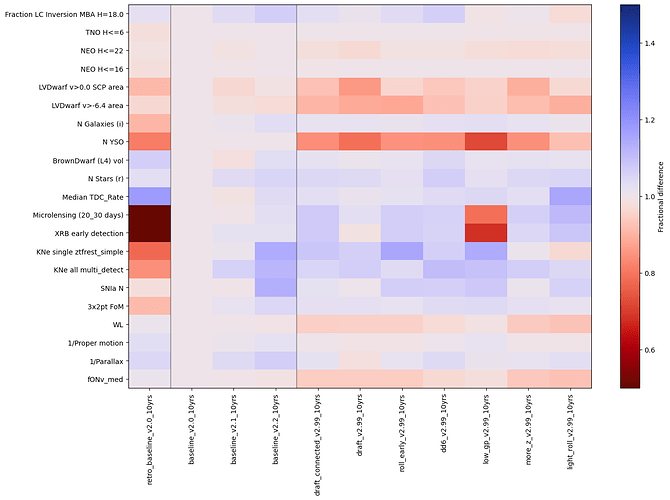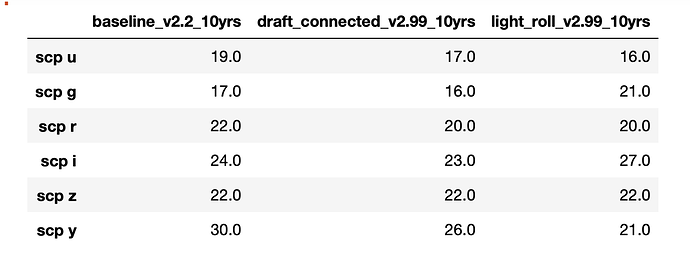Hi @chrisusher many thanks for this plot. I worked with @lgirardi in particular to include lists of both open and globular clusters in the combined science maps of ‘high priority regions’ that I produced, so I tried to include as many of them as possible when proposing the current GalPlane footprint. The limits on the area we can cover at different cadence was the limiting factor which meant I could not include more of them, so I worked with Leo to come up with a way of assigning priority so that at least some important ones are included. However, this is a highly tunable approach, so there is more we can do to optimize it, and it would be interesting to know whether your science requires time domain or deep sky imaging and in what filters?
Hi Chris - thanks for the awesome plots! Is it fair to say that because extragalactic GCs around known systems from the Karachentsev+ catalog will be fairly bright, it would be OK to focus most of the SCP on gi or gri bands, as long as at least a couple/few visits were obtained in other bands to provide colors?
Thanks, @fed - good to keep in mind that updates in one area may have unintended efficiency impacts elsewhere. I agree that the metrics (for all the science) should allow this to be assessed.
Yes, it would be ok to focus on gi or gri. For the extragalactic star cluster science there is not an either or - have more bands and deeper bands would help but you can still do some science with only a single colour. In terms of filter balance I would prefer to keep the existing u-band depth but to transfer most of the z and y into g and r.
It’s worth keeping in mind that the SCP only has about 20 visits per band currently. I assume there is some minimum number of visits required to produce decently calibrated data.
I agree with Chris. For stellar population studies the u filter is more important compared to the z and y filters. Those are difficult to calibrate and there are not many models available.
@chrisusher re: minimum number of visits required to produce decently calibrated data: do we already have metrics for this? I would think there would be some straightforward threshold on the m5metric for example. Does the LV dwarf satellites metric do what you need (example evaluation here for draft_connected_v2.99_10yrs)? @jeffcarlin almost certainly has a good answer for this.
I have started an openly-editable google doc as a scratchpad for rubin_sim experiments we might request. Edits and contributions are most welcome, currently this is very rough.
For those available, I’ve set up a Zoom telecon for Friday November 11th at 11:00am EST to discuss the experiments we will want to request. This will not be the final word - so if you cannot make this telecon, there will be more time to work on the requests - but I would like us to at least have a trial-balloon set of simulations to request by the end of this telecon.
Connection information is in the google doc linked above.
For information on the four v2.99 opsim experiments, including the new “connected” footprint and the “low plane” footprint, please see this Community post by Lynne:
Quick reminder about the 11:00am EST telecon today, for those who can make it. Connection and agenda are in the google doc.
Thanks to those who were able to participate in the telecon just now, which was most productive. The livenotes are at this link (in the shared google doc).
I’ve given myself the action to write up trial-balloon tables of opsim requests we might make. I will post on this thread when I’ve done that… modulo local obligations, I expect to get this done during the day today (Fri Nov 11).
I’ve sketched the table of experiments for the SCP region, the GP region will take a little longer. The google doc will update live, here is how the first draft of the table currently looks. The first row is the current baseline (draft_connected_v2.99_10yrs) for comparison.
| Experiment | u | g | r | i | z | y | sum | notes |
|---|---|---|---|---|---|---|---|---|
| 2.99 draft | 17 | 16 | 20 | 23 | 22 | 26 | 124 | Figures are median nexp per SCP field |
| 1 gi-heavy | 15 | 37 | 15 | 37 | 15 | 5 | 124 | |
| 2 gri-heavy | 15 | 30 | 29 | 30 | 15 | 5 | 124 | |
| 3 griz-heavy | 15 | 26 | 26 | 26 | 26 | 5 | 124 |
This is just a first draft, though - improvements are sorely needed! For example, for the “minimum” coverage, I made up the figures of 15 exposures for all but y, and 5 exposures for y-band. Cutting the minimum further would free up more exposures for the filters chosen for deeper coverage.
@chrisusher @jeffcarlin @knutago @strader @rstreet @rmr @jgizis @calamida @jsobeck
This is cool, thanks Will!
My preference would go to solution number 2 (gri-heavy), and I would put Y exposures to 0 and move those 5 o the u filter, so it would become 20 30 29 30 15
I’ve added some trial-balloon “Galactic plane” specifications that we might request, into the shared google doc (this link should take you to the section “Galactic Plane” in that doc). I think this covers most of the options we discussed in the telecon today.
Comments and improvements are most welcome. Hopefully we can get this refined into a set of specification we can sensibly request from Lynne, Peter and the sims team.
@chrisusher @jeffcarlin @knutago @strader @rstreet @rmr @jgizis @calamida @jsobeck
If it’s helpful - note that the “light_roll_v2.99_10yrs” simulation now has a modified SCP and GP filter balance (the footprint is still the same, and I believe needs to cut visits unfortunately).
The SCP filter balance isn’t modified too heavily, but g and I band were increased at the expense of u, r, z, and y (most heavily in y). So it’s a minor modification, but does bring the “LVDwarfs V<0.0 SCP” metric most of the way back towards baseline_v2.2 levels while still maintaining the survey legacy value of covering the SCP in all filters.
The filters balances are modified not as strongly as in your example 1, however.
Please note that 5 visits in y band would mean one visit every two years.
Coverage in all filters has strong merits, but it’s worth noting that the NES does not include u or y band coverage, so it should not really be required. The NES, like the SCP is also beyond the airmass limit that helps define the north and south boundaries of the low-dust WFD region. This means that u band will have particularly worse seeing and correspondingly lower limiting magnitudes, compared to similar visits in the WFD.
Thanks, @ljones - this is very helpful. Am I correct that any spatial selection in the metrics you show above, takes place in the metric itself? (E.g. LV Dwarfs V>0.0 SCP Area is the only one of those metrics that currently assesses the SCP specifically?)
Also I think for @ljones - what might be the best way for us to translate our rough specifications for filter balance and/or footprint into formats that the simulations team can use? Cc’ing @rstreet
Of the SCP scenarios, I favor the gri-heavy option (or perhaps griz-heavy if there are strong arguments for keeping z-band coverage).
In general, yes, that is how we run these metrics (and how they are configured).
The LVDwarfs V>0.0 SCP area metric is relevant to only the SCP as only fields with dec < -60 are included.
You can see more information on the LVDwarfs metric here –
Some other metrics are spatially “aware” because their input population of objects (such as microlenses) is not uniform.
I will go and look at your google doc in some more detail. I think we’ve had some miscommunication in the past regarding how we’d like things to be provided, that is probably easier to clear up if we also know what you’re trying to do.
@willclarkson I had a look at the google doc in some more detail and made a few comments ("–LJ" where they’re inline).
One nice thing though is that we have a simulation or two (the “draft2*v2.99” sims) which come pretty close to matching your first suggestion for GP coverage.
The second thing is that we have also updated the SCP coverage to at least more g band visits, although it doesn’t match your SCP wish list exactly. OTOH, it does bring the LVdwarf metric back to ~ baseline_v2.2 levels.

